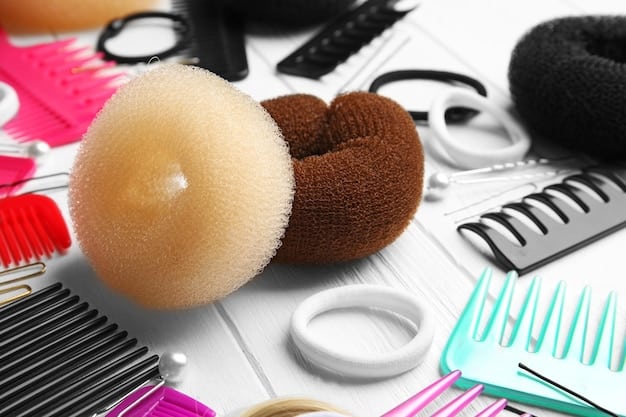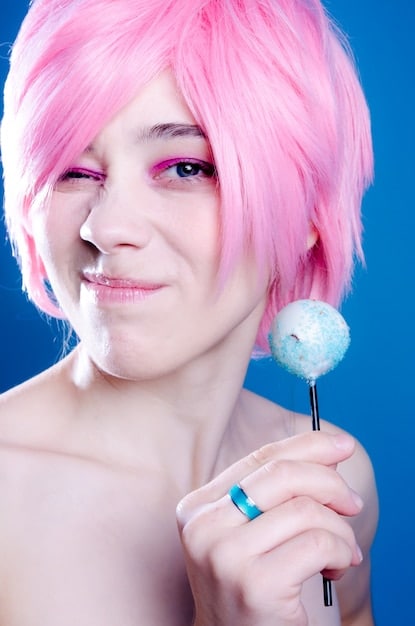Anime-Perfect Hair: Cosplay Wig Styling Secrets Revealed

Achieving anime-perfect hair for cosplay demands specialized wig styling techniques, encompassing fiber preparation, precise cutting and shaping, heat styling for intricate details, and the strategic use of styling products to create durable, character-accurate looks.
For any cosplayer aiming for authenticity, the wig is often the crowning glory. It’s not just about finding the right color or length; it’s about transforming a static piece of fiber into a dynamic representation of a beloved character’s hairstyle. Mastering the Cosplay Wig Styling Secrets: Achieve Anime-Perfect Hair with These Pro Tips and Tricks is what truly elevates a costume from good to extraordinary. This guide delves into the essential techniques, tools, and insights needed to bring those fantastical anime hairstyles to life with precision and flair.
The Foundation: Wig Selection and Preparation
Choosing the right wig is the crucial first step before any styling can begin. It’s akin to an artist selecting their canvas. The wrong foundation can undermine even the most skilled styling efforts. Experienced cosplayers know that synthetic wigs come in various fiber qualities, each offering different levels of heat resistance, texture, and natural appearance. High-quality Kanekalon or Futura fibers are often preferred for their malleability and ability to withstand heat styling tools, which are essential for anime styles. Beyond fiber type, considering the wig’s cap construction is also vital; a lace front can offer a more natural hairline, while a skin top provides a realistic part, both elevating the final look.
Once acquired, the wig needs preparation. Out of the bag, most wigs have a factory sheen and sometimes an unnatural stiffness. A gentle wash with a mild shampoo and conditioner, followed by air drying, can significantly improve its texture and reduce shine, making it more amenable to styling. Detangling is also paramount; use a wide-tooth comb or a wig brush, starting from the ends and working your way up to prevent damage. This early care ensures the fibers are smooth and ready, laying the groundwork for complex styling and helping to manage flyaways.
Furthermore, consider the base color and length. Sometimes a wig may need custom dyeing to achieve a specific shade, a process that requires careful execution with specialized dyes to avoid damaging the synthetic fibers. If a character has highlights or streaks, it might be more effective to purchase wefts in different colors and sew them into the wig cap rather than attempting to dye small sections. Always think ahead to the final desired style when selecting and preparing your wig; foresight here saves time and frustration later on.

Essential Tools for Anime Wig Styling
Just as a chef relies on their knives, a wig stylist depends on a specialized toolkit. Having the right instruments at hand streamlines the styling process and allows for greater precision. This section details the indispensable tools that every aspiring wig stylist should invest in, ensuring they are prepared for any intricate anime hairstyle. Proper tools not only make the job easier but also prevent damage to the delicate wig fibers.
Key Cutting Instruments
- Wig Scissors: Unlike regular hair scissors, wig scissors are often designed to cut synthetic fibers cleanly without fraying. Investing in a sharp pair is paramount for crisp layers and precise bangs.
- Thinning Shears: These are invaluable for removing bulk and creating natural-looking layers, especially in characters with voluminous hair that still needs a sense of lightness.
- Razor Comb: Excellent for texturizing ends and creating soft, blended layers that mimic natural hair movement.
Heat Styling Appliances
Heat is often a cosplayer’s best friend for wig styling. Most quality synthetic wigs are heat-resistant, but always check the wig’s specifications to avoid melting the fibers.
- Hair Straightener: Perfect for flattening fibers, creating smooth sections, or even adding gentle waves at lower temperatures.
- Curling Iron/Wands: Essential for creating intricate curls, spirals, and flips. Using a lower heat setting and allowing curls to cool completely before releasing them from the iron helps them hold their shape.
- Heat Gun/Hair Dryer: These are vital for shaping spikes, creating gravity-defying volumes, and setting styled sections. A heat gun offers more focused heat for precise reshaping.
Styling Products and Adhesives
Beyond the tools, a range of products helps to sculpt and hold the desired shape.
- Wig Hairspray: Different strengths are needed for different effects. A strong hold is crucial for spikes, while a lighter hold can be used for softer styles. Look for formulations specifically designed for synthetic wigs.
- Got2b Glued Blasting Freeze Spray: A cult favorite among cosplayers, this spray provides an almost invincible hold, perfect for gravity-defying spikes and extreme shapes.
- Hair Glue/Fabric Glue (e.g., Aleene’s Tacky Glue): Used sparingly, these can secure stubborn strands, bond wefts, or create sharp, defined edges that hairspray alone cannot achieve.
- Styling Wax/Pomade: Useful for adding texture, defining strands, and controlling flyaways without the stiffness of hairspray.
Having a dedicated wig head is also non-negotiable. It allows you to work on the wig as if it were on a head, ensuring balanced and accurate styling from all angles. Moreover, a robust wig stand keeps the wig secure during the entire styling process. A meticulous stylist understands that preparation and the right tools are not merely convenient; they are foundational to achieving truly stellar anime-inspired hair.
Cutting and Shaping: Mastering the Silhouette
The true artistry of wig styling begins where the scissors meet the fiber. Cutting and shaping are not merely about shortening length; they are about sculpting a unique silhouette that captures the essence of the character. Precision is key. A common mistake is to cut too much at once. Instead, trim in small increments, constantly checking against reference images to ensure accuracy. For characters with distinct layers, like many anime protagonists, begin by establishing the longest layers first, then gradually work your way up to the shorter sections around the face and crown.
When dealing with bangs, always cut them while the wig is on a wig head, positioned similar to how it would sit on your own head. This accounts for the natural curve of the wig cap and ensures the bangs fall correctly. Use a sharp pair of scissors and cut vertically into the hair (point cutting) rather than straight across to create a softer, more natural edge. For spiky styles, cutting layers of different lengths helps to create dimension and allows the spikes to form more easily. Thinning shears are invaluable here, removing bulk without sacrificing length, making the wig lighter and more dynamic.
For particularly complex shapes, such as gravity-defying spikes or voluminous puffs, shaping is an ongoing process. It involves a combination of cutting, teasing, and heat setting. Teasing (backcombing) the underside of sections adds volume and a stronger foundation for spikes. After teasing, gentle brushing on the surface can smooth out the visible fibers while maintaining the volume underneath. The goal is to achieve the character’s iconic shape while maintaining a natural flow and avoiding a stiff, helmet-like appearance. Patience and an eye for detail are your greatest assets in this stage.
Advanced Heat Styling Techniques
Heat styling is where many anime hairstyles truly come to life, allowing for manipulation of synthetic fibers into extraordinary shapes. However, mastering heat requires understanding its nuances and respecting the wig’s limits. Most synthetic wigs can tolerate temperatures from 250°F to 350°F (120°C to 175°C), but it’s crucial to test a small, inconspicuous section of the wig first. Too much heat will melt the fibers, resulting in irreversible damage.
Creating Defined Spikes and Curls
For sharp, gravity-defying anime spikes, a heat gun or even a strong hairdryer is essential.
- Spiking: Isolate a section, apply a strong-hold hairspray or gel, and use clips to hold it in the desired spike shape. Apply targeted heat from your heat gun/hair dryer, moving it constantly to prevent scorching. Allow the section to cool completely before removing clips. Repeat as needed, layering spikes for complexity.
- Curling: Wrap small sections of hair around a curling iron or even household items like rollers or curlers (secured with pins). Apply heat, then allow the fiber to cool completely. The cooling process is what sets the curl in synthetic wigs, making it just as important as the heating. Unroll gently.
Shaping and Setting Volume
Achieving intricate volumes often involves a blend of heat and product.
- Volume at the Roots: Tease the root area extensively, then gently smooth the top layer. Use a hairdryer on a low-medium setting while carefully shaping with your hands or a comb. Finish with a firm hold hairspray to lock it in.
- Fiber Manipulation: For complex bends or curves that natural hair wouldn’t hold, heat can be used to “train” the fibers. For example, to create a sharp inward curve on a bang, use a straightener on a low setting, gently bending the fiber around a rounded object (like a pencil or your finger, protected from heat) while applying heat.
Remember, heat styling often requires repetition and patience. Don’t be afraid to redo sections if they don’t meet your expectations. The goal is to create a dynamic look that holds up throughout a convention. Always work in a well-ventilated area when using heat tools and sprays, and protect your workspace.
The Magic of Styling Products and Adhesives
While cutting and heat lay the groundwork, it’s the strategic application of styling products and adhesives that truly brings an anime wig to life, providing hold, texture, and durability. Knowing which product to use and how to apply it can mean the difference between a wig that looks good for an hour and one that lasts all day. The most iconic anime styles often require an almost architectural approach, building up layers of product to defy natural hair behavior.
Hairsprays: The Backbone of Hold
Not all hairsprays are created equal for wig styling. For extreme anime styles, you’ll need the “industrial strength” options. Products like Got2b Glued Blasting Freeze Spray are revered in the cosplay community for their unparalleled hold, capable of locking spikes and gravity-defying shapes into place.
- Application: Apply in light, even coats from a distance. For spikes, spray individual sections, then hit them with a hairdryer on a cool setting or a heat gun on low to speed up drying and setting.
- Layering: For maximum hold, build up layers of hairspray. Allow each layer to dry completely before applying the next. This creates a stronger, more resilient shape.
Glues and Adhesives: For Unwavering Structure
For some of the most extreme styles, traditional hairspray might not be enough. This is where specialized glues come into play.
- Hair Glue/Fabric Glue (e.g., Aleene’s Tacky Glue, E6000 diluted): These can be used, sparingly and cautiously, to bond wefts, secure stubborn sections that need to lie completely flat, or to create incredibly sharp, defined edges that replicate drawn anime lines. Always dilute thicker glues with a bit of water for easier application, and test on a small section first.
- Contact Cement: For very large, solid shapes or armored elements integrated into a wig, contact cement can provide an extremely strong bond. This is an advanced technique and requires proper ventilation and safety precautions.
Wax, pomade, and modeling clay (specifically for wigs) are also excellent for adding texture, separation, and controlling flyaways without the hard, crunchy feel of excessive hairspray. These products allow for finer adjustments and detail work, making a wig appear more natural even with an extreme style. Learning the properties of each product and experimenting with their application is key to unlocking their full potential.
Troubleshooting Common Wig Styling Challenges
Even the most seasoned cosplayers encounter wig styling hurdles. Knowing how to troubleshoot these common issues can save a project from disaster and ensure a smooth styling process. Patience and problem-solving are crucial when dealing with unexpected fiber behavior or styling mishaps.
Dealing with Frizz and Flyaways
Frizz is a notorious enemy of sleek anime styles. Synthetic fibers, especially lower quality ones, can become frizzy with handling or friction.
- Solution: Invest in anti-static spray or a fabric softener diluted with water. Lightly mist the wig and gently comb through. A small amount of styling wax or pomade can also tame individual flyaways. Ensure your styling tools are clean and smooth to avoid pulling fibers.
When Spikes Don’t Hold
Achieving those iconic, gravity-defying spikes can be tricky. If your spikes are drooping, it’s often a matter of product application or setting.
- Solution: Revisit your layering technique with hairspray. Ensure you’re building up multiple light coats, allowing each to dry completely. Reinforce the base of the spike with more hairspray and use a heat gun (on low) to further set the shape while holding it in place. Sometimes, adding a small piece of florists’ wire inside particularly large spikes can provide internal support, but this must be done discreetly.
Managing Overly Shiny Wigs
Many new synthetic wigs come with an unnatural, plasticky sheen that detracts from the character’s look.
- Solution: A gentle wash with fabric softener (diluted) and air drying can often help. For persistent shine, a light dusting of translucent powder or dry shampoo can dull the artificial gloss. Apply lightly and brush through for an even finish.
Preventing Tangling During Styling
Longer wigs are prone to tangling, especially during rigorous styling.
- Solution: Work in very small sections. Keep the rest of the wig clipped away or braided to prevent it from getting in your way. Consistently detangle with a wide-tooth comb from the ends upwards. A silicone-based detangling spray can also be a lifesaver.
Remember that learning from mistakes is part of the process. Sometimes, it’s best to step away, reassess, and approach the problem with fresh eyes. Watching tutorials from other experienced cosplayers can also provide invaluable insights into tackling specific character styles.
Maintaining Your Masterpiece: Post-Styling Care
Once you’ve poured hours into perfecting your anime wig, the last thing you want is for it to lose its shape or get damaged. Proper post-styling care and storage are just as vital as the styling process itself. A well-maintained wig can last for countless conventions and photo shoots, extending the life of your meticulously crafted cosplay.
Proper Storage to Preserve Style
How you store your wig directly impacts its longevity and how well its style holds.
- Wig Head Storage: The ideal method is to store your styled wig on a wig head, preferably a sturdy styrofoam or canvas block head. This maintains its shape, volume, and prevents crushed spikes or flattened curls. Cover it with a wig cap or a plastic bag (secured loosely) to protect it from dust.
- Wig Boxes: For highly complex or fragile styles, custom wig boxes can be incredibly useful. These provide rigid protection, preventing any external pressure from distorting the style.
- Avoid Direct Sunlight and Extreme Temperatures: Prolonged exposure to sunlight can fade wig fibers, while extreme heat or cold can affect the integrity of styling products and the fiber itself.
Cleaning and Refreshing Between Uses
While extensive washing might be necessary after a particularly messy convention, sometimes a simple refresh is all that’s needed.
- Spot Cleaning: Use a damp cloth with a mild soap to gently clean any makeup or dirt spots. Avoid submerging the entire wig if it has a complex style that might be ruined by water.
- Hairspray Touch-ups: If a few strands come loose or a spike droops slightly, a quick touch-up with strong-hold hairspray and a heat gun can often rectify the issue.
- Odor Removal: Lightly misting with a fabric refresher or airing the wig out can help remove any lingering odors from convention halls.
Handling Your Styled Wig
Even the most carefully styled wig needs careful handling when putting it on or taking it off.
- Gentle Approach: Always handle the wig by the cap or the sides, avoiding direct pressure on delicate styled sections.
- Transporting: When traveling, place the wig in a secure box or carry it by hand (on its wig head) rather than stuffing it into a bag, which can crush the style.
By implementing these post-styling care strategies, you ensure that your anime-perfect hair remains perfect, cosplay after cosplay. It’s an investment in your craft and a testament to your dedication to accuracy.
| Key Styling Aspect | Brief Description |
|---|---|
| ✨ Wig Selection | Choose high-quality, heat-resistant fibers for best styling results. |
| ✂️ Precise Cutting | Use wig-specific scissors and thinning shears for sharp, anime-accurate layers. |
| 🔥 Heat Mastery | Utilize heat guns/irons to sculpt spikes and curls, allowing ample cooling time. |
| 💪 Product Application | Layer strong-hold sprays and glues for extreme, durable styles. |

Frequently Asked Questions About Wig Styling
Heat-resistant synthetic fibers like Kanekalon or Futura are generally preferred. They can withstand low to medium heat from styling tools, allowing you to create sharp spikes, defined curls, and intricate shapes without melting the wig. Always check the wig’s specific heat tolerance before beginning any heat styling.
Work in small sections, securing the rest of the wig with clips or braids. Use a wide-tooth comb or wig brush, starting from the ends and working upwards. A detangling spray can also be very helpful. Avoid excessive handling and be gentle with the fibers to minimize friction and knotting.
The secret lies in layering strong-hold hairspray, such as Got2b Glued Blasting Freeze Spray, and setting the shape with heat. Tease the roots for a solid base, spray each section thoroughly, shape it into a spike, and then use a heat gun (on low) or hairdryer (cool setting) to “set” the fiber. Allow it to cool completely.
Yes, but not with traditional hair dyes. Synthetic wigs require specialized dyes designed for nylon or polyester fibers, often alcohol-based or fabric dyes. Alternatively, using fabric markers or airbrushing with acrylic paints can also change the color. Always test on a small, hidden section first to ensure desired results and fiber integrity.
The best way is to store it on a wig head (styrofoam or canvas) to preserve its volume and shape. Cover the wig with a wig cap or a light plastic bag to protect it from dust and environmental factors. For very intricate styles, a dedicated wig box offers excellent protection against crushing or distortion during transport or storage.
Conclusion
Mastering the art of cosplay wig styling is an evolutionary process that combines technical skill with artistic vision. It’s about more than just recreating a hairstyle; it’s about embodying a character, expressing passion, and pushing the boundaries of what synthetic fibers can achieve. By meticulously selecting the right wig, arming yourself with essential tools, employing advanced cutting and heat styling techniques, and strategically utilizing styling products, you can transform a simple wig into an anime-perfect masterpiece. Remember, practice, patience, and a willingness to troubleshoot are your greatest allies on this creative journey. With these insights, you are well-equipped to unlock your full potential and bring your favorite anime characters to life with stunning, authentic hair.





